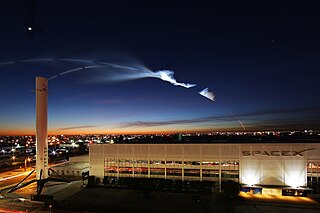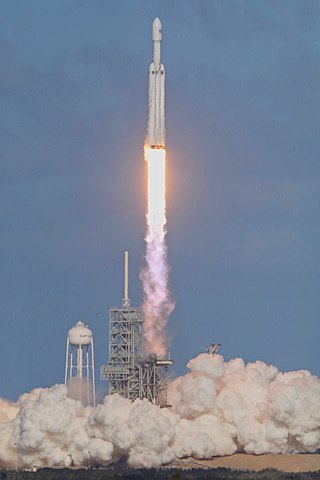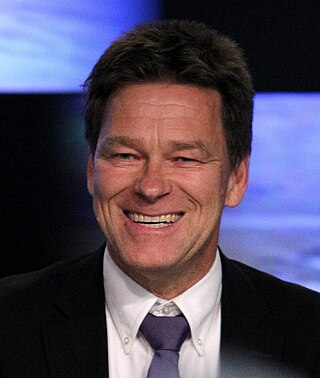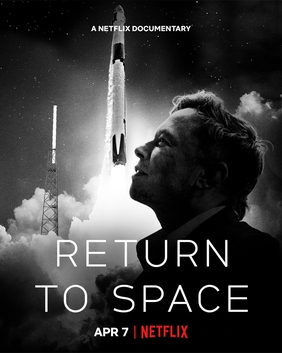
A reusable launch vehicle has parts that can be recovered and reflown, while carrying payloads from the surface to outer space. Rocket stages are the most common launch vehicle parts aimed for reuse. Smaller parts such as rocket engines and boosters can also be reused, though reusable spacecraft may be launched on top of an expendable launch vehicle. Reusable launch vehicles do not need to make these parts for each launch, therefore reducing its launch cost significantly. However, these benefits are diminished by the cost of recovery and refurbishment.

Private spaceflight is spaceflight or the development of spaceflight technology that is conducted and paid for by an entity other than a government agency.

Space Exploration Technologies Corp. (SpaceX) is an American spacecraft manufacturer, launcher, and a satellite communications corporation headquartered in Hawthorne, California. It was founded in 2002 by Elon Musk with the stated goal of reducing space transportation costs to enable the colonization of Mars. The company manufactures the Falcon 9, Falcon Heavy, and Starship launch vehicles, several rocket engines, Cargo Dragon and Crew Dragon spacecraft, and Starlink communications satellites.

Falcon 1 was a small-lift launch vehicle that was operated from 2006 to 2009 by SpaceX, an American aerospace manufacturer. On 28 September 2008, Falcon 1 became the first privately-developed fully liquid-fueled launch vehicle to go into orbit around the Earth.
Andy Pasztor is a former journalist with The Wall Street Journal. He is the author of the 1995 book When the Pentagon was for Sale: Inside America's Biggest Defense Scandal. Pasztor also appeared in the 2022 documentary film Downfall: The Case Against Boeing, which examined Boeing's role in two fatal crashes of the Boeing 737 MAX: Lion Air Flight 610 and Ethiopian Airlines Flight 302.

Falcon Heavy is a partially reusable heavy-lift launch vehicle produced by SpaceX, an American aerospace manufacturer. The rocket consists of a center core on which two Falcon 9 boosters are attached, and a second stage on top of the center core. Falcon Heavy has the second highest payload capacity of any currently operational launch vehicle behind NASA's Space Launch System, and the fourth-highest capacity of any rocket to reach orbit, trailing behind SLS, Energia and the Saturn V.

SpaceX CRS-2, also known as SpX-2, was the fourth flight for SpaceX's uncrewed Dragon cargo spacecraft, the fifth and final flight for the company's two-stage Falcon 9 v1.0 launch vehicle, and the second SpaceX operational mission contracted to NASA under a Commercial Resupply Services (CRS-1) contract.
The SpaceX Mars program is a set of projects through which the aerospace company SpaceX hopes to facilitate the colonization of Mars. The company claims that this is necessary for the long-term survival of the human species and that its Mars program, including the ongoing development of the SpaceX Starship, will reduce space transportation costs, thereby making travel to Mars a more realistic possibility.

As of 2023, SpaceX operates four launch facilities: Cape Canaveral Space Launch Complex 40 (SLC-40), Vandenberg Space Force Base Space Launch Complex 4E (SLC-4E), Kennedy Space Center Launch Complex 39A (LC-39A), and Brownsville South Texas Launch Site. Space Launch Complex 40 was damaged in the AMOS-6 accident in September 2016 and repair work was completed by December 2017. SpaceX believes that they can optimize their launch operations, and reduce launch costs, by dividing their launch missions amongst these four launch facilities: LC-39A for NASA launches, SLC-40 for United States Space Force national security launches, SLC-4E for polar launches, and South Texas Launch Site for commercial launches.

The Falcon 9 v1.0 was the first member of the Falcon 9 launch vehicle family, designed and manufactured by SpaceX in Hawthorne, California. Development of the medium-lift launcher began in 2005, and it first flew on June 4, 2010. The Falcon 9 v1.0 then launched four Dragon cargo spacecraft: one on an orbital test flight, then one demonstration and two operational resupply missions to the International Space Station under a Commercial Resupply Services contract with NASA.

Lunar tourism may be possible in the future if trips to the Moon are made available to a private audience. Some space tourism startup companies are planning to offer tourism on or around the Moon, and estimate this to be possible sometime between 2023 and 2043.

A super heavy-lift launch vehicle can lift a super heavy payload to low Earth orbit. A super heavy payload is more than 50 metric tons (110,000 lb) by United States (NASA) classification or 100 metric tons (220,000 lb) by Russian classification. It is the most capable launch vehicle classification by mass to orbit, exceeding that of the heavy-lift launch vehicle classification. Only thirteen such payloads were successfully launched prior to 2022: twelve as part of the Apollo program before 1972 and one Energia launch in 1987. Planned crewed lunar and interplanetary missions often depend on these launch vehicles' payload capacity.

The billionaire space race is the rivalry among entrepreneurs who have entered the space industry from other industries - particularly computing. This private industry space race of the 21st century involves sending rockets to the ionosphere, orbital launch rockets, and suborbital tourist spaceflights.
The Mars race; or race to Mars; or race for Mars; is the competitive environment between various national space agencies, "New Space" and aerospace manufacturers involving crewed missions to Mars, land on Mars, or set a crewed base there. Some of these efforts are part of a greater Mars colonization vision, while others are for glory, or scientific endeavours. Some of this competitiveness is part of the New Space race.

This is a corporate history of SpaceX, an American aerospace manufacturer and space transport services company founded by Elon Musk.

Elon Musk's Tesla Roadster is an electric sports car that served as the dummy payload for the February 2018 Falcon Heavy test flight and became an artificial satellite of the Sun. A mannequin in a spacesuit, dubbed "Starman", occupies the driver's seat. The car and rocket are products of Tesla and SpaceX, respectively, both companies headed by Elon Musk. The 2010 Roadster is personally owned by and previously used by Musk for commuting to work. It is the first production car launched into space.

The Falcon Heavy test flight was the first attempt by SpaceX to launch a Falcon Heavy rocket on February 6, 2018, at 20:45 UTC. The successful test introduced the Falcon Heavy as the most powerful rocket in operation at the time, producing five million pounds-force (22 MN) of thrust and having more than twice the payload capacity of the next most powerful rocket, United Launch Alliance's Delta IV Heavy.

Hans-Jörg Koenigsmann is a German aerospace engineer who was Vice President of Flight Reliability for SpaceX until his retirement in 2021.

VP-03 was a sub-orbital spaceflight of the SpaceShipTwo-class VSS Unity which took place on 13 December 2018, piloted by Mark P. Stucky and co-piloted by Frederick W. "CJ" Sturckow.

Return to Space is an American documentary film made for Netflix and directed by Jimmy Chin and Elizabeth Chai Vasarhelyi. Its story follows Elon Musk's and SpaceX engineers' two-decade mission to send NASA astronauts back to the International Space Station and revolutionize space travel. The film was released on April 7, 2022.

















